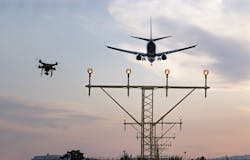Federal, local use of counter-UAS solutions still up in the air
As security personnel at airports across the country gear up this week for what promises to be one of the busiest Thanksgiving travel seasons on record, lawmakers on Capitol Hill have yet to take concrete action on one of the biggest threats facing modern aviation: the increasing use of unmanned aerial systems (UAS), commonly referred to as “drones.”
While there have been numerous sightings and close calls between drones and jetliners around the world in recent years, last December’s incident at London’s Gatwick Airport in which operations were disrupted over a three-day period following repeated drone sightings in the area, demonstrated the disruptive impact that UAS can have on air travel. In fact, it is estimated that the attack cost the airport £1.4 million. Despite this and other incidents, the options available to law enforcement and others to counter the problem remain limited.
Although the FAA Reauthorization Act signed into law late last year gives the U.S. Department of Homeland Security (DHS) the authority to disable drones that pose a threat to buildings or other assets, the use of counter-drone technology is still limited to the federal government and military, leaving end-users and the vast majority of law enforcement agencies in a tough position. Even the limited authority given to DHS is now be called into question by lawmakers as recently released details on how the agency plans to mitigate the threat has raised concerns.
In fact, after the TSA made it known that it would like to give air marshals the ability to operate counter-UAS solutions to take down drones that pose a risk at airports, Reps. Sam Graves (R-Mo.) and Mike Rogers (R-Ala.) sent a letter to Acting DHS Secretary Chad Wolf expressing opposition to the proposal. “We believe this concept of operations is wholly inconsistent with, and contrary to the legislative intent of, the limited C-UAS authority provided by Congress to DHS,” the letter states.
Beyond this type of action being inconsistent with authority given DHS, the congressmen say that the agency’s experience in using such technology is “sorely lacking.”
According to Timothy Bean, CEO of counter-UAS technology provider Fortem Technologies, there’s still great deal of tension legislatively between the freedom to fly for drone operators and security for airports and other critical infrastructure facilities, however; the world is now moving largely toward security in the wake of Gatwick and other incidents.
“At the local, state and federal levels across the world, they are having those discussions about freedom to fly versus security and security is winning,” he says.
While he applauds DHS, TSA and others with coming up with plans to disable drones flying in restricted airspace, Bean says he also understand the desire on the part of Congress to ensure that the measure being used won’t inflict harm on the people and aircraft they’re intended to protect. “Congress realizes, and so do the American people, that these counter measures need to be safe,” he adds.
One of the biggest challenges facing authorities, according to Bean, is a lack of funding to implement safe counter-drone solutions.
“That’s why DHS through TSA is asking for resources from the DOD to act,” he says. “We think that Congress needs to take two steps: first they need to provide money to these agencies to be able to respond to this threat. Secondly, they need to give the same authorities that they've given to DOJ and DHS to, as a pilot program, some key state and local governments – NYPD, LAPD, Massachusetts Port Authority, etc. These leading law enforcement agencies in our country need the same authority pushed down from the federal level to the state level so that they can act.”
Because the threats presented by drones extend well-beyond airports, Bean emphasizes that local law enforcement has just as much need for counter-UAS technology, if not more so, than the federal government.
“State and local authorities do not have the authority to do anything,” Bean adds. “If you have a drone problem over your venue, you call your mayor not the FAA. The federal government needs to push these authorities down to state and local (agencies).”
About the Author:
Joel Griffin is the Editor of SecurityInfoWatch.com and a veteran security journalist. You can reach him at [email protected].



